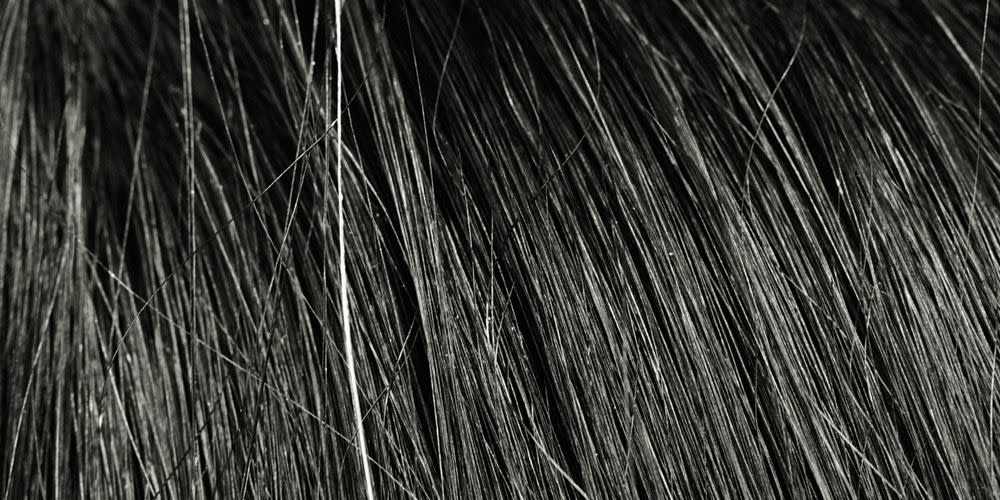Everything You Need to Know About That Gray Hair You Just Spotted

One day you're just living your life, and the next, BAM!, a gray hair pops up out of nowhere. What exactly triggers this sudden change in your hair, you ask? Anabel Kingsley, consultant trichologist and Director of Communications at Philip Kingsley Trichological Clinic, gets to the silvery root of it all below.
Help! Why is my hair going gray?
Gray hairs pop up when your body stops producing pigment cells aka the melanin in your strands that gives them their color, Kingsley says. "But the hair isn’t actually gray, it’s just un-pigmented or colorless," she says.
However, if you've ever really inspected a gray hair (you're not alone, we've all done it under the bathroom vanity light), you'd see that the strand almost looks yellow. This is because keratin, the protein that makes up your hair, has a naturally yellow tint to it. So, when your hair loses its melanin, the yellow hue of keratin shows through, Kingsley explains.
Okay, but is going gray genetic?
The main cause of grays are the genes you inherit, so yes, that's part of it. "When we go gray [it] can be inherited from either our mother or father’s side of the family," she says-i.e. if your mom and dad went gray when they were young, then you have a greater chance of it happening to you around the same age. Alternatively, if they didn't see grays until much later in life, then most likely you won't either. Kingsley also adds that due to genetics Caucasian people tend to go gray sooner (around their 30s) than any other ethnicity, while those with African-American and Asian backgrounds tend to develop gray hairs later in life.
Stress, too, can play a role in losing the melanin in your hair, but you'd still have to have the genetic predisposition, while a vitamin B deficiency has also been linked to premature graying, Kingsley adds. "That isn’t to say that if you take loads of vitamin B that your hair won’t go gray," she clarifies. "It’s just that if you have a deficiency in vitamin B you might go gray sooner than you normally would."
I want to hide my grays. What's the most effective way to conceal them?
Unfortunately there’s no way to reverse or delay graying hair (if that's what you're looking to do); luckily, Kingsley has a few recommendations on how to hide grays if you're not yet ready to embrace them-and how to care for silver strands if you're ready to welcome them.
1. Dye your hair.
Rule No. 1? DO NOT pluck grays to get rid of them. "If you repeatedly pluck silver hairs,-or any hair actually-it can damage the hair follicle, eventually causing the hair to stop growing all together," Kingsley warns. So, to camouflage their appearance longer, which can help them blend into the rest of your hair color better, dyeing your hair is one of the best options.
That said, whether you're coloring your hair at a salon or at home, Kingsley recommends using a pre-shampoo conditioning treatment to ensure your hair is sufficiently moisturized. By age 50-when most people go significantly gray, according to Kingsley-half of your hair will be gray and will be overall finer in texture. This age is also when your sebaceous (aka oil) glands produce less, which can also make the hair feel dry. And since color only further dries out the hair, it's important to take the proper precautions in keeping your mane properly nourished.
2. Add highlights.
"If you don’t want to go darker with your color [to cover grays], getting highlights also helps to camouflage any silver strands that come through so they’re not as obvious," Kingsley says. Not only will the multiple shades and dimension from the highlights help blend your grays, but they'll also allow you to target the areas where they tend to pop up, like your hairline, the crown of your head, and along your part.
3. Use temporary concealers, like powders and sprays.
Kingsley suggests waiting six to eight weeks between coloring your hair to minimize any breakage. But what about my roots..?! That's what hair temporary concealers are for. Although they can be inconvenient if you have a lot of grays, these short-term solutions are handy if you're only noticing a few grays here and there between hair color appointments.
Wait, I'm actually into my silver strands, but do I have to care for them differently?
Just because you have gray hairs cropping up, whether it's just a couple or a full head of them, doesn't mean you have to cover them up. If you're looking to embrace your grays, but want them to look their best (obvi), Kingsley recommends using products designed for silver hair, like the Philip Kingsley Pure Silver Shampoo and Conditioner. Toning products, such as these formulas, fix brassiness and discoloration commonly found in gray hair.
Another way to protect your gray hair is using sun protection. "If over 50 percent of your hair is un-pigmented, it’s more prone to UV damage," Kingsley says. Melanin offers more protection from the sun's rays, so if your hair doesn't have any, it can become discolored, frizzy, dry, or brittle quicker.
So, there you have it. While graying is irreversible, there are actions you can take to address them - or totally embrace them. Up to you!
Follow Lauren on Instagram.
('You Might Also Like',)


